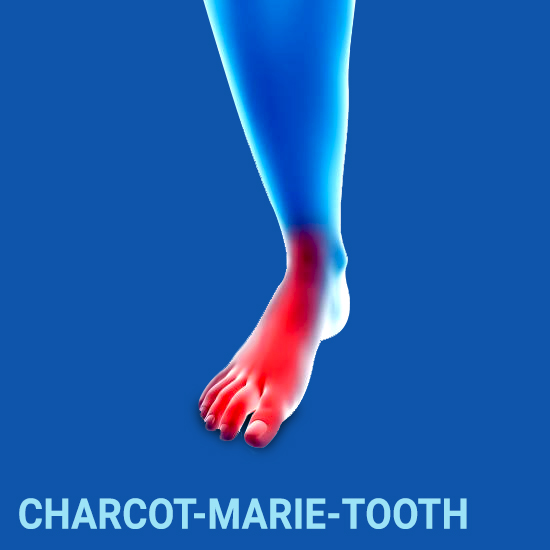Charcot Marie Tooth
 Charcot-Marie-Tooth (CMT) disease (a group of disorders) affects the nerves that carry messages between the brain and muscles throughout the body (peripheral nerves). All types of Charcot-Marie-Tooth disease leads to muscle weakness, some loss of sensation in the arms, legs, hands, and feet, resulting in degeneration of the peripheral nerves. The initial sign of CMT is distal weakness and atrophy, which manifest with foot drop and pes cavus (high arched feet). A shortened foot with a pes cavusis the most common foot deformity resulting due to the muscles that lift the foot at the ankle become weak, muscles that lower and curl the downward foot contract and tighten. As the contracture gets worse, the toes can become locked in a flexed position. The symptoms of CMT mostly appear during adolescence or early adulthood and can develop later in life. If left untreated, the contractures and secondary abrasions tend to worsen over time, making walking increasingly difficult.
Charcot-Marie-Tooth (CMT) disease (a group of disorders) affects the nerves that carry messages between the brain and muscles throughout the body (peripheral nerves). All types of Charcot-Marie-Tooth disease leads to muscle weakness, some loss of sensation in the arms, legs, hands, and feet, resulting in degeneration of the peripheral nerves. The initial sign of CMT is distal weakness and atrophy, which manifest with foot drop and pes cavus (high arched feet). A shortened foot with a pes cavusis the most common foot deformity resulting due to the muscles that lift the foot at the ankle become weak, muscles that lower and curl the downward foot contract and tighten. As the contracture gets worse, the toes can become locked in a flexed position. The symptoms of CMT mostly appear during adolescence or early adulthood and can develop later in life. If left untreated, the contractures and secondary abrasions tend to worsen over time, making walking increasingly difficult.
Causes
Charcot-Marie-Tooth is a congenital disease which means it is Hereditary, inherited from one’s parents. There are 30 known genetic causes for CMT. Few namely,
- Duplication of a gene on chromosome 17
- Defect in peripheral nerve cells axon
- Gene mutation
Symptoms
- Toe-walking, frequent tripping, ankle sprains, clumsiness
- Burning sensation in the feet.
- Weakness in legs, ankles and feet
- Hammertoes – curled toes
- Loss of sensation to touch
- Awkward gait
- High foot arches
- Loss of muscle in your legs and feet
- Walking may become difficult
- Deformities in the bones of the feet
Diagnosis
- Genetic Testing, need a sample of your blood
- Nerve conduction studies
- Nerve biopsy
- Electromyography
Treatment
CMT treatment mainly involves occupational therapy to increase your muscle strength and prevent atrophy, or muscle loss. Use ofAssistive devices to help you grab, reach, and push objects. Custom made shoes, orthotics, Medications and in some cases, surgical treatment to correct foot deformities.
Recovery
The treatment will help the patients cope with the condition. Doctors, occupational therapist and assistive device professionals with help in understanding the situation and support in managing and living with the disorder.
